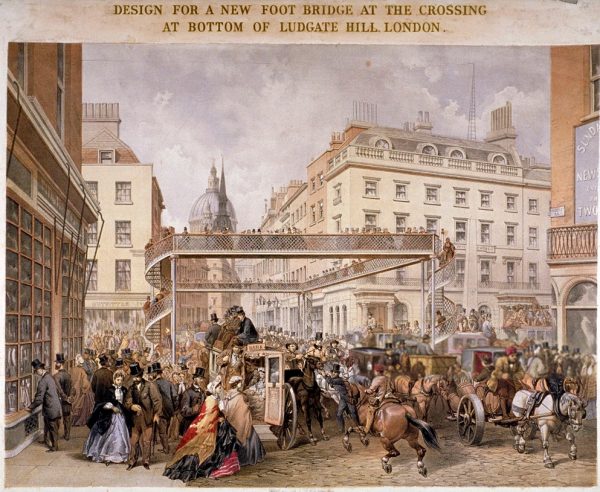A marvel of the industrial age, a mighty iron footbridge permitting safe and quick passage for pedestrians over congested and dirty streets.
At least, that was the plan.
London’s streets have always been crowded, but in the middle of the 19th century, things were the worst they have ever been. It was the road congestion that lead to London having the first-ever underground railway, but there were other problems.
In London’s free-for-all roads with no official traffic regulations, a pedestrian wanting to cross the road pretty much took their life in their hands.
But as roads were often slimy in horse manure (and occasionally, horse blood from an accident), and the detritus of human trade and cargo, to cross a road in the congested city was both unpleasant and dangerous.
The City looked for alternatives, such as road tunnels, but with the ongoing construction of the Metropolitan railway already causing alarm at the amount of disruption it caused, this was never going to be allowed.
One of the plans was drafted by Manchester based ironworks and inventor, Thomas Dunn.
Thomas Dunn was born in 1813, and after working in iron foundries while young, by the time he was 23 he was in charge of works on the railways in charge of hundreds of men.
He tried setting up a foundry which was not a success, but he is noted for the 23 patents he took out on new designs for improved machinery while he was based in Manchester.
In 1863, following a call for ideas from the City Commissioners of Sewers, Dunn proposed his “aerial bridge”, a cast iron walkway with spiral staircases to elevate pedestrians above the muck of London’s streets.
This rather famous painting of the footbridge is an exercise in Victorian exaggeration. Look at how small the people are while crossing the bridge compared to the people on the ground.
Victorian paintings often enlarged the size of their industrial achievements to make them seem grander than they were. There is no way the bridge had it been built would have carried that many people, unless it was restricted to children only.
Obviously, the footbridge was never constructed.
The reason given was that while the roads were dangerous, it was felt that there was more risk of accidents from people falling down the stairs.
Had it been, it wouldn’t have lasted, as not much later, the traffic light was invented in 1868, and it eventually brought order to the disordered roads, and while the horse muck remained, at least hansom cabs and omnibuses were held back to permit pedestrians to pass in safety, if not cleanly across London’s dirty streets.
Sources:








They had a similar idea for the City on the 70/80’s. Many walkways and bridges were built elevated from the road but it never really took off, I am sure somebody here will know more. Remnants can be seen along London Wall and Wormwood Street.
This short film gives an excellent account of the City of London’s Pedways.
https://vimeo.com/80787092